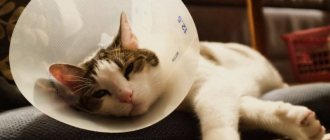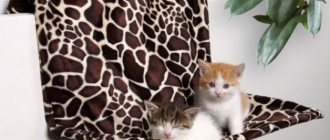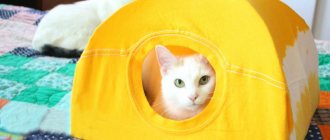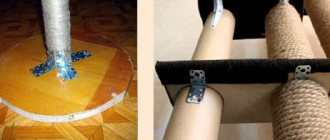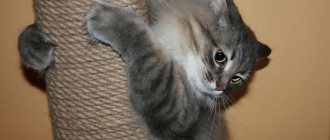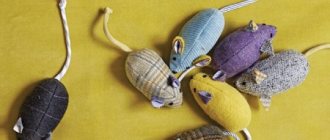Treatment of diseases associated with damage to the skin, itching, suppuration, etc., requires keeping the skin dry and clean. This prevents the addition of a secondary infection and accelerates the regeneration of the skin. Of course, it is impossible to monitor your pet around the clock, so during illness and rehabilitation he is given an Elizabethan collar. How to choose it and how long does a cat need to walk in it?
History of the name, design and purpose of the Elizabethan collar
A device for protecting the skin from licking by a cat has many names: veterinary, medical, Elizabethan collar. The last name is most often used, because this design is similar to a lush accessory, which was especially popular during the reign of Queen Elizabeth I of England. The device is a cone-shaped structure made of dense material, the base of which corresponds to the circumference of the cat’s neck.
This device is designed to prevent the cat from licking healing wounds, stitches, etc., as well as to prevent the licking of veterinary medications in the form of ointments and sprays. A correctly selected and put on cone does not restrict the cat’s movements, does not cause him discomfort, and does not interfere with eating and drinking. Of course, the animal tries to remove it in the first days, but then gets used to it and does not notice it until the end of treatment.
Choosing a product in the store
There is a certain numbering: No. 7 (7.5 cm), No. 10 (10.5 cm), No. 12 (12 cm), No. 15 (15 cm), No. 20 (21.5 cm), No. 25 (25 cm ). The number or size refers to the width of the protective field.
The protective collar should hold well, but not be tight. It is enough for one finger to pass between the neck and collar.
For kittens use No. 7, No. 10 is suitable for a medium-sized cat and No. 12 for a large cat.
It will not be difficult to find and buy such a product, especially since it is inexpensive. The main problem will be finding the right size. In this case, you can make a protective collar for your cat with your own hands using what you have at home.
Indications for a cat to wear a protective cone
An Elizabethan collar is worn on a cat when:
- diseases of the ears and eyes - constant scratching and licking of medications interferes with recovery;
- injuries - to prevent infection;
- infectious and parasitic diseases - to avoid repeated self-infection;
- during abdominal operations, including castration, sutures must be protected from infections and mechanical impact with a rough tongue;
- treating skin and wool with external antiparasitic and antifungal drugs that have a toxic effect.
Which is better - a veterinary collar or a blanket?
The choice depends on the purpose of wearing: in the postoperative period after castration, it is better for the cat to wear a blanket, after antiparasitic treatment and in case of head injury, and also for a newly neutered cat - a collar.
The blanket prevents not only the pet from licking the seam, but also its contact with other objects. True, it gets dirty quickly and needs to be changed after each seam treatment. The collar does not allow the cat to wash itself and comb its ears, but it can prevent it from hiding in its favorite secluded place, which it especially needs during illness.
Size chart of protective collars for cats - table
The big advantage of this category of veterinary product is that it can be selected in size according to the parameters of the animal. The following table will help you buy the right barrier cap:
How to make a house for a cat with your own hands: patterns
| Neck circumference (cm) | Collar height (cm) | Marking number |
| 22-25 | 7 | 7 |
| 22-25 | 10 | 10 |
| 28-33 | 12 | 12 |
| 31-38 | 15 | 15 |
| 38-44 | 20 | 20 |
| 44-50 | 25 | 25 |
| 47-57 | 30 | 30 |
This information is very helpful when purchasing a barrier for your furry friend.
The main thing is to take measurements of your pet correctly. For your information! A cat collar can be made from cardboard, plastic, fabric and other materials. Each of them has its own pros and cons.
How to choose a ready-made collar and how much can it cost?
To choose a good collar for a cat, you need to consider:
- Its correspondence to the size (neck circumference) of the animal. You cannot buy a product for growth. If it dangles around the neck, of course, the cat will take it off. A correctly chosen item does not restrict movement and does not put pressure on the neck: it is necessary that a finger can pass freely between it and the collar. Do not overtighten the collar or bandage to which the collar is attached, for reliability and strong fixation, so as not to provoke strangulation.
- Weight. The collar should not be too bulky and massive: such a device causes discomfort to the pet, preventing it from leading an active lifestyle. When making a product with your own hands from fabric, choose light but dense materials.
- Safety. Of course, it is best to buy a transparent collar that does not obscure the cat's view. If the choice falls on a fabric model, choose medium-sized products. When buying an item, you need to make sure that it does not have any odors or sharp edges - indicators of defects. If the edge of the collar is still processed carelessly, for the safety of the animal it is covered with tape or adhesive tape.
When choosing a collar, they are also guided by such factors as the presence of individual intolerance to certain materials and the approximate duration of treatment for the pet. To prevent cats from licking, they wear the following protective collars:
Plastic collar
- Plastic. The most popular type of collar. The product is made of lightweight transparent plastic. Its disadvantage is that it is the least comfortable for a pet among all models and the noise it makes when it comes into contact with other objects. The price of the product depends on the presence of additional elements: simple models cost 100–150 rubles, products covered with elastic or piping to protect against cracking cost about 350 rubles, with a collar – up to 1000 rubles. depending on size.
Soft Elizabethan collar
- Soft. This model is made of water-repellent hypoallergenic materials. The product is distinguished by its convenience (you can even sleep in it, so it is worn during a long-term illness) and affordable price (a simple model costs about 150–200 rubles, a collar-pillow with synthetic padding filler costs more than 1000 rubles), but also impracticality. While wearing it, it loses its shape and the pet reaches the wounds. Due to the opacity of the material, it is more difficult for animals to navigate in space in such a cone than in a plastic one.
Inflatable postoperative collar
- Inflatable. This model is also made of waterproof fabric, but its shape is supported by air chambers. The collar is characterized by the greatest comfort - it is comfortable for the pet to walk in it, it can clearly see the surrounding space, thanks to which it can be worn for a long time. The disadvantages of these products are the risk of damage from animal claws, so good models have an additional nylon coating, and the highest price among all types (a high-quality product costs more than 1,500 rubles).
Scope and benefits
The medical collar for cats has a wide range of uses in the field of veterinary medicine. It is used to quickly heal wounds, prevent the development of secondary infections, and perform hygiene procedures.
Destination areas:
- pathologies of the eyes, ears;
- skin diseases;
- removal of parasites;
- applying plaster to the limbs;
- postoperative period;
- external use of drugs.
In all areas, the barrier therapy accessory provides great benefits to your pet's health.
Beneficial effects of a protective collar for cats:
- Topical medications only provide benefits after absorption. Some of them are toxic and have negative effects when taken orally. The protective accessory prevents the cat from licking medications, which promotes rapid healing of wounds and reduces the risk of poisoning.
- After abdominal operations, sutures are tightened faster when dry. Licking wounds prevents the repair of damaged tissue. Scratching surgical sutures may cause bleeding. Using a protective device reduces the rehabilitation period.
- During deworming, animals should not lick their fur. The eggs of parasites that leave the body with bowel movements remain on it. Wearing a medical collar will prevent re-infection with helminths.
- When treating ear diseases, you should not injure your cat's head. Any additional wound leads to complications of the inflammatory process and suppuration. A veterinary barrier therapy device will prevent the animal from scratching the affected ear.
- External injuries with burns become wet during the regeneration process. Additional moisture slows down wound healing. With an E-collar, the cat will not be able to reach injured areas with its tongue.
Some animals behave aggressively during hygiene procedures. By putting a protective item on a cat, the owner will protect himself from its bites and claws.
How to put on a cone correctly?
The procedure is best carried out by two people: one person should hold the animal, and the second should put on its collar. The main thing is to do everything carefully and not to rush, so that the cat’s stitches do not come apart (for example, after castration). To put a protective collar on a cat, you need to:
- assemble the product following the instructions and attach it to the collar or bandage;
- place the pet on a flat surface and secure it with your hands;
- put on a collar with a collar and check whether it is too tight for the cat, then fasten all the elements of the structure;
- calm your pet down - give him his favorite treat, pet him and pick him up.
You need to keep an eye on the animal, as it can get stuck in narrow passages or cling to other objects. To avoid dermatosis, it is necessary to regularly check the skin of your pet’s neck for abrasions - this can happen if you use a rough collar, a heavy structure, or fix it with the same non-sterile bandage every day. Due to the fact that it is difficult for a cat to lick itself because of the collar, it is necessary to comb its fur more often.
Operating instructions
The benefit of a protective accessory is observed when the cat cannot independently remove the structure from the body and deform it with its paws. When wearing them, it is not allowed to block the side view, make breathing difficult, or rub the skin in the neck area. These results are achieved by matching the size of the collar and the dimensions of the cat.
Size chart for barrier therapy medical devices for cats:
| Accessory size | Neck length | Collar width | Who is it suitable for? |
| №1 | 15-17 cm | 8 cm | kittens |
| №2 | 20-24 cm | 10.5 cm | teenagers |
| №3 | 27-31 cm | 12 cm | average cat |
| №4 | 30-34 cm | 14 cm | big cats |
Veterinary devices that protect animals from self-harm are sold in finished form. Their assembly is carried out according to the scheme prescribed in the instructions.
Step-by-step connection of the components of the collar with the straps:
- The right edge of the structure with slotted holes overlaps the paired holes on top.
- A long strip is inserted into rectangular passages.
- Short straps are tucked into the upper paired holes.
- The animal's collar is threaded through the formed slot holes.
Protective item with straps for a cat, assembled.
Veterinary barrier therapy products with Velcro are assembled faster. To do this, just put them on the animal’s neck and then secure it with a textile fastener.
All medical collars without side effects or contraindications. There are no precautions for use. They are stored in a dry, dark place, with a relative humidity of no more than 75%.
Shelf-life Unlimited.
Making a postoperative cap with your own hands
You can choose a collar to suit every taste, but if it is needed urgently, and the owner cannot immediately purchase the device, it is made with his own hands.
Regardless of the material chosen, the main thing in its manufacture is convenience and safety for the pet, so you need to carefully follow the instructions and correctly take measurements from the cat. How to make a collar at home?
Rigid plastic bottle design
This is the most practical product that can be used throughout the entire treatment period. To make a collar from a plastic bottle, you need:
Soft stopper made of thick fabric or foam rubber
It is recommended to sew soft collars from natural fabrics so as not to provoke an allergic reaction in your pet. Instructions for sewing a soft collar:
What to look for when choosing
A veterinary accessory significantly complicates the life of an animal, so its choice should be taken with full responsibility. Choosing a veterinary collar for a cat is quite difficult, since you need to take into account many nuances.
The part of the product adjacent to the neck should be soft, ideally covered with fabric. The height of the cone should not be too high so as not to interfere with the view. However, a low one will not work, otherwise it will lose its functionality.
Additional Information! Size is the most important criterion. The kitten should not remove the product easily. But it is worth considering that a narrow collar will put pressure on the neck. A product that holds its shape well is considered good.
